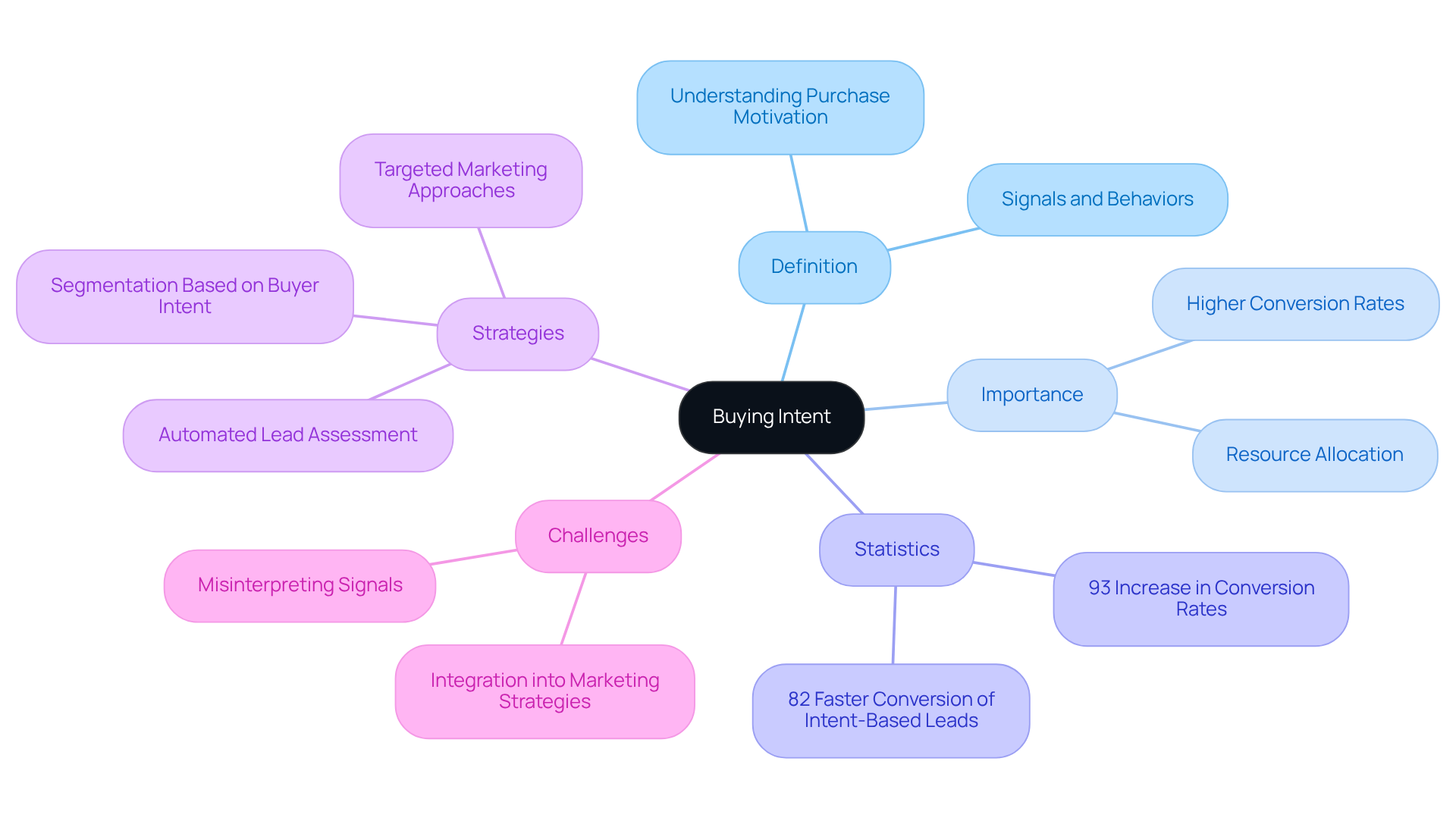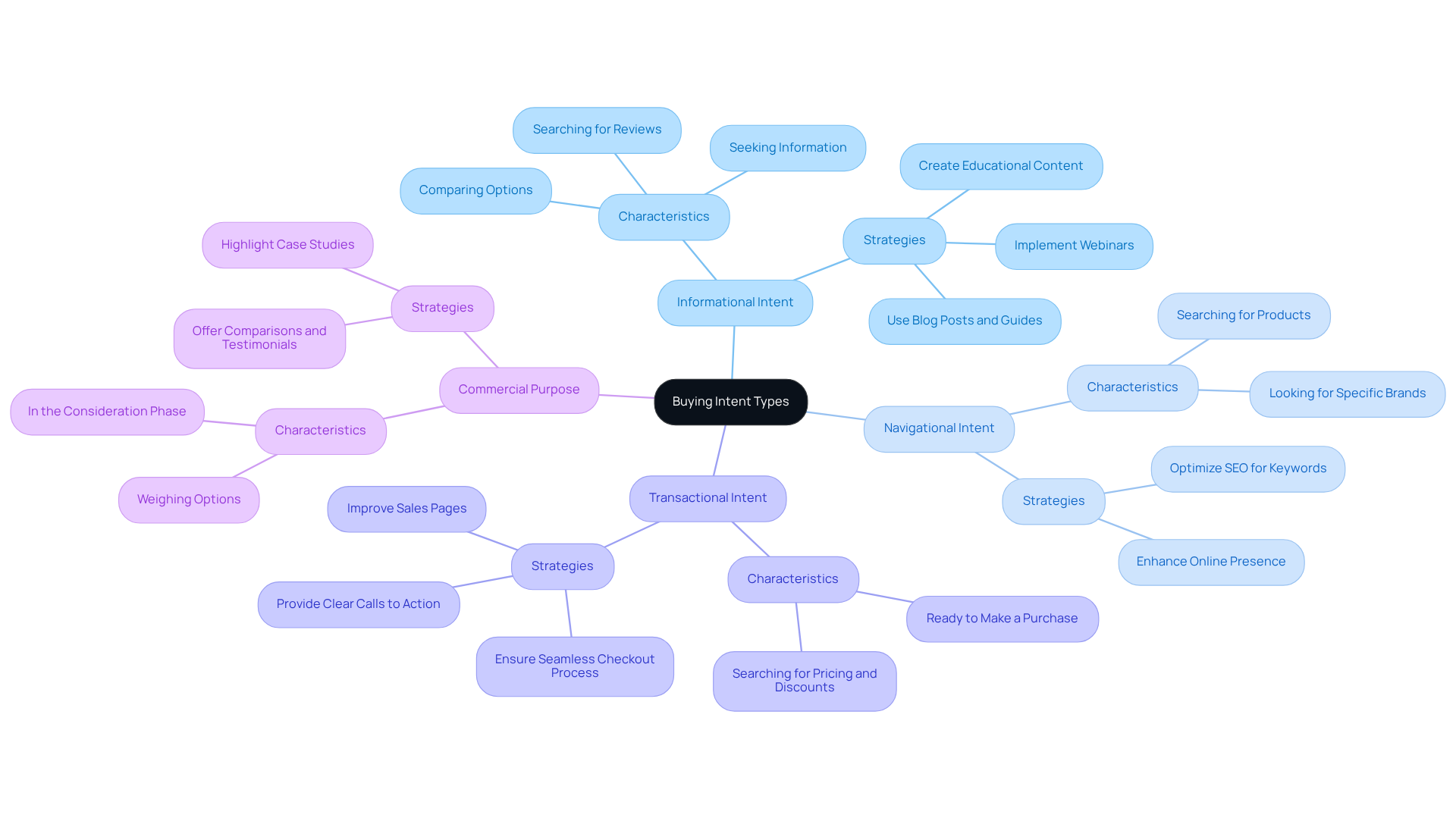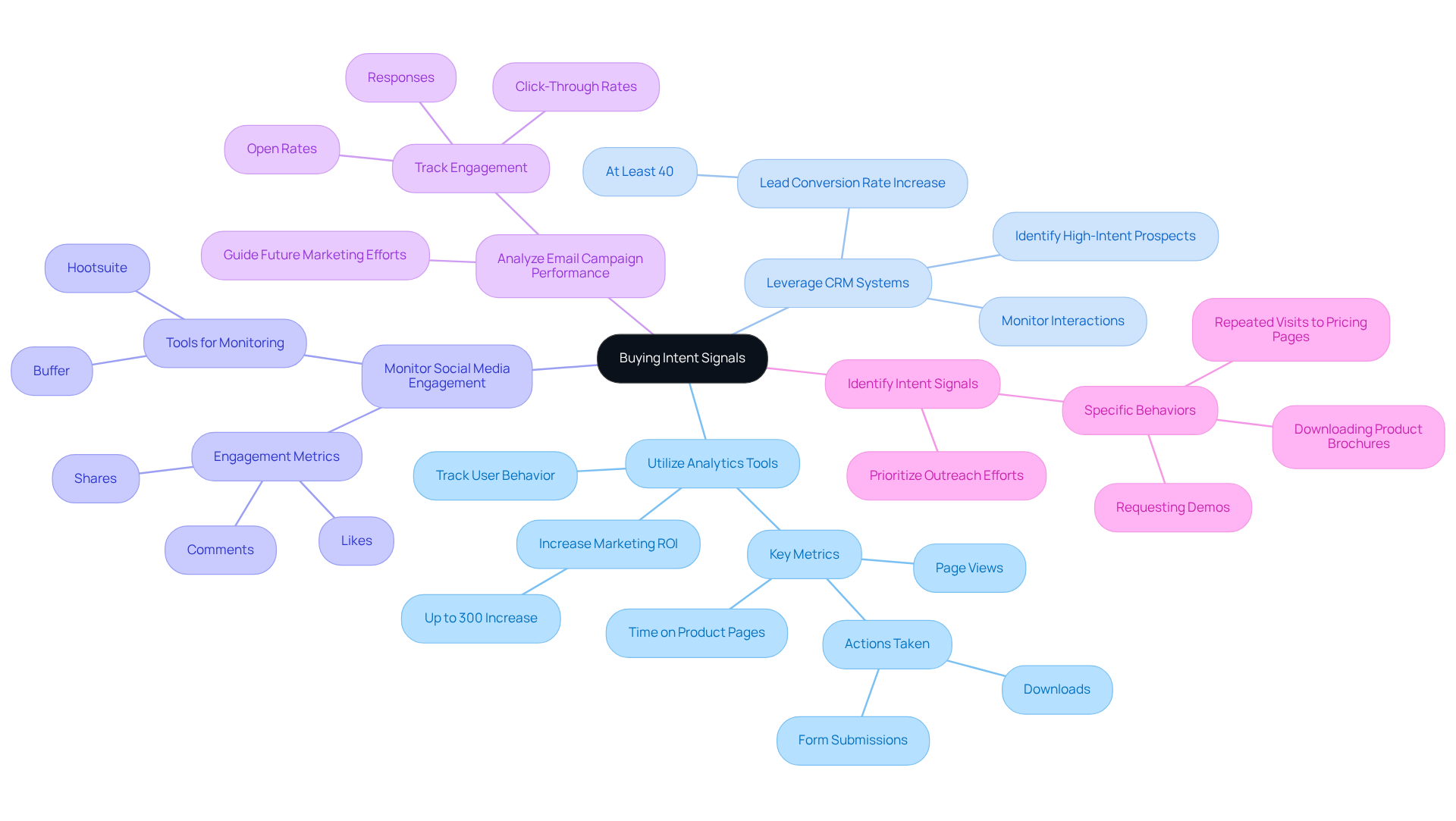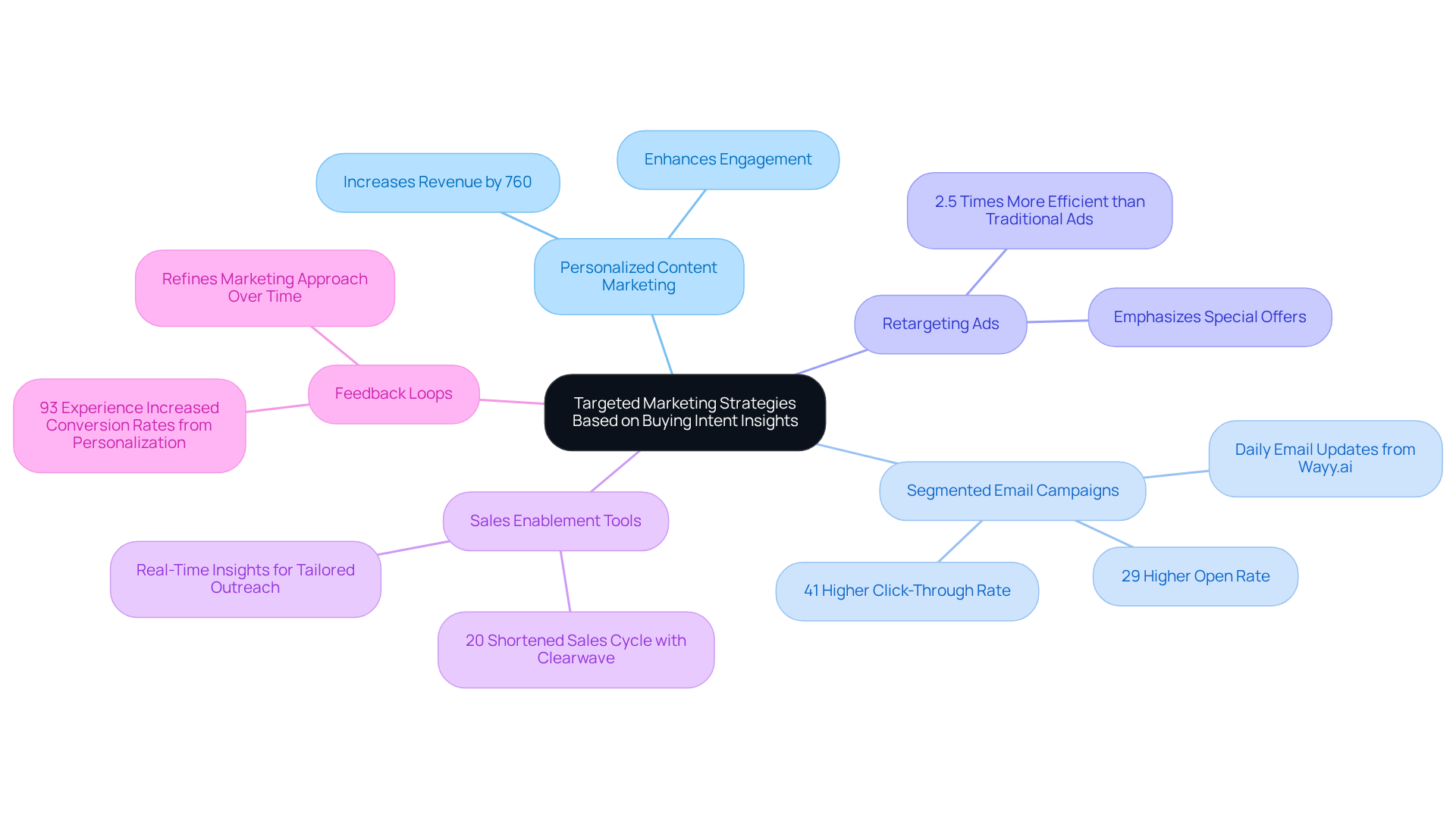Overview
Understanding and mastering buying intent is crucial for small businesses looking to boost sales. By identifying and prioritizing leads based on their readiness to purchase, you can create a more effective marketing approach. Imagine how empowering it would feel to leverage insights from buying intent—this can significantly enhance your marketing strategies and conversion rates. Statistics show that businesses that tailor their approaches to align with customer motivations experience higher success rates. Together, we can navigate these challenges and find the best path forward for your business.
Introduction
Understanding the motivations behind customer purchases can truly be a game-changer for small businesses eager to enhance their sales. By mastering buying intent, you can not only tailor your marketing strategies but also significantly boost your conversion rates. But with so many signals and behaviors to analyze, how can you effectively identify and leverage these insights? This article explores the nuances of buying intent, offering actionable strategies designed to transform how small enterprises connect with potential customers and ultimately drive sales. Together, we can navigate this journey toward success.
Define Buying Intent and Its Importance for Small Businesses
Understanding buying intent, or purchase motivation, is crucial for small business owners like you, as it indicates how ready a potential customer is to make a purchase. By analyzing various signals and behaviors that reflect a customer's interest in your product or service, you can prioritize leads and tailor your marketing messages. This thoughtful approach can ultimately increase your conversion rates. Focusing on high-intent leads allows you to allocate resources more effectively, leading to better sales outcomes.
In today's competitive landscape, tapping into buying intent can significantly enhance your ability to connect with prospective clients at the right moment. Did you know that research shows 93% of B2B marketers experience higher conversion rates when leveraging data on purchasing behavior? This highlights the importance of understanding buying intent as a key component of your sales strategy. Moreover, 82% of B2B marketers report that their sales teams can convert leads based on interest more quickly than traditional leads. This strategic focus not only boosts your sales results but also supports the overall success of your business in a rapidly evolving market.
Consider platforms like Wayy.ai, which offer an affordable solution at just $99/month, making the client acquisition process simpler and more accessible, even without a sales background or complex setup. Wayy.ai provides features like automated lead assessment and targeted marketing approaches, helping you effectively utilize buying intent. However, it's essential to be aware of the challenges in leveraging this data efficiently. Misinterpreting signals or failing to act on insights can hinder your marketing outcomes. By integrating these insights into your strategies and investing in tools and training that foster effective use, you can improve your sales results and contribute to your overall success. Together, we can navigate these challenges and achieve your business goals.

Identify Key Types of Buying Intent Relevant to Your Business
Understanding the various types of buying intent is essential for small enterprises aiming to enhance their marketing strategies. Let’s explore these key types together:
-
Informational Intent: This motivation arises when potential customers seek information about a product or service, often comparing options or searching for reviews. Small enterprises can effectively reach these customers by creating educational content—think blog posts, how-to guides, or webinars that address common questions and concerns. Wayy.ai's daily email updates can help you track which leads engage with this content, offering valuable insights into customer interests.
-
Navigational Intent: Customers with navigational intent are on the lookout for a specific brand or product. To connect with this audience, it’s crucial for businesses to enhance their online presence, ensuring they stand out in search results for relevant keywords. Wayy.ai's metrics can assist in identifying which keywords are driving traffic, empowering companies to refine their SEO strategies accordingly.
-
Transactional Intent: This motivation indicates that a customer is ready to make a purchase, often searching for pricing, discounts, or specific product features. Small enterprises should focus on improving their sales pages, providing clear calls to action, and ensuring a seamless checkout process to encourage conversions. Notably, 55% of sales leaders report improved lead conversions when utilizing purpose data, underscoring the effectiveness of targeting transactional motivations. With Wayy.ai's daily email updates, you can monitor how many leads were reached, who showed interest, and track conversion rates, enabling you to refine your strategies effectively.
-
Commercial Purpose: Customers showing commercial purpose are in the consideration phase, weighing their options before making a decision. To influence their choice, businesses can offer comparisons, testimonials, and case studies that highlight the benefits and value of their products or services. As buyer motivation data reveals a potential customer's buying intent based on online behavior, leveraging this information can significantly enhance marketing efforts. Wayy.ai's insights into lead interest and conversion trends can help small enterprises tailor their offerings to better meet customer needs.
By recognizing and leveraging these forms of purchasing motivation, small business owners can develop targeted marketing strategies that resonate with their audience, ultimately driving sales and fostering customer loyalty.

Monitor and Analyze Buying Intent Signals for Effective Outreach
To effectively monitor and analyze buying intent signals, small businesses can adopt the following strategies:
-
Utilize Analytics Tools: Implement tools like Google Analytics to track user behavior on your website. By focusing on key metrics such as page views, time spent on product pages, and actions taken (e.g., downloads, form submissions), you can uncover trends in customer interest and engagement. Research indicates that companies employing purposeful information can achieve up to a 300% rise in marketing ROI. This shows how these tools can significantly boost your sales success.
-
Leverage CRM Systems: Employ Customer Relationship Management (CRM) systems to monitor interactions with leads. Analyzing communication frequency and content engagement can help identify high-intent prospects, allowing for more targeted outreach. Furthermore, 57% of B2B teams report a lead conversion rate rise of at least 40% when utilizing data on buyer behavior. This highlights the importance of these strategies in your journey toward growth by addressing buying intent.
-
Monitor Social Media Engagement: Track social media interactions to gauge interest levels. Engagement metrics such as likes, shares, and comments can provide valuable insights into potential buyers. Tools like Hootsuite or Buffer can streamline this monitoring process, making it easier for you to stay updated on audience interactions and connect with them meaningfully.
-
Analyze Email Campaign Performance: Evaluate the performance of your email campaigns by tracking open rates, click-through rates, and responses. High engagement with specific content can suggest strong purchasing motivation, guiding your future marketing efforts. This understanding can empower you to create more impactful communication.
-
Identify Intent Signals: Look for specific behaviors that suggest intent, such as repeated visits to pricing pages, downloading product brochures, or requesting demos. Identifying these signals enables you to prioritize outreach efforts efficiently, ensuring that you connect with prospects demonstrating buying intent at the right moment.
By consistently observing these signals, small enterprises can engage prospects at the ideal moment, significantly enhancing the chance of conversion. Nevertheless, it is crucial to recognize the difficulties linked to buyer purpose information tools. In fact, 67% of B2B marketers state that information quality is the most significant characteristic regarding purpose solutions. Incorporating reliable analytics tools is essential for maximizing the benefits of these strategies. Moreover, 98% of companies discover that utilizing purpose data enhances the effectiveness of their marketing and sales initiatives. Together, we can navigate these challenges and achieve success in your business.

Implement Targeted Marketing Strategies Based on Buying Intent Insights
To effectively utilize insights on buying intent, small businesses can adopt targeted marketing strategies that truly resonate with their audience. Here are several impactful approaches that can make a difference:
-
Personalized Content Marketing: Consider developing content that directly addresses the unique needs and challenges of your target audience. For instance, if you identify a segment seeking information, crafting blog posts or guides that provide valuable insights can enhance engagement and establish your authority. In fact, personalized content marketing can increase revenue by as much as 760%, showcasing its significant impact on sales.
-
Segmented Email Campaigns: By leveraging your CRM information, you can categorize your email list based on purchasing motivation. Tailoring your messaging for each segment ensures it aligns with their specific interests and buying intent to purchase. Personalized emails can achieve a 29% higher open rate and a 41% higher click-through rate, significantly boosting engagement. With Wayy.ai, you can receive daily email updates that provide key metrics on how many leads were reached, who showed interest, and how conversion rates are improving, allowing for more informed email campaigns.
-
Retargeting Ads: Implementing retargeting campaigns can engage users who have shown interest in your products but have not yet converted. Using ads that emphasize special offers or remind them of the benefits of your products can be particularly effective, as intent-based ads are reported to be 2.5 times more efficient than traditional ads.
-
Sales Enablement Tools: Equipping your sales team with tools that offer real-time insights into buying intent can be transformative. This enables them to tailor their outreach and follow-ups based on the prospect's current stage in the buying intent journey, enhancing the likelihood of conversion. For example, Clearwave successfully shortened their sales cycle by 20% using intent-based personalization, demonstrating the effectiveness of such tools. Wayy.ai's features, including the one-click sales playbook and targeted outreach, allow your team to see exactly what's working every day, ensuring they focus on the most promising leads.
-
Feedback Loops: Creating systems to consistently collect information on the effectiveness of your marketing strategies is crucial. Analyzing this data allows you to refine your approach and improve engagement over time, ensuring that your marketing efforts remain relevant and effective. Notably, 93% of companies experience increased conversion rates from personalization, underscoring the importance of these feedback mechanisms.
By implementing these targeted strategies, small businesses can significantly enhance their outreach efforts, connecting with prospects in a meaningful way and driving conversions. Additionally, 76% of consumers have indicated that receiving personalized communications makes them more likely to consider purchasing from brands, further emphasizing the value of personalization.

Conclusion
Understanding and mastering buying intent is a crucial strategy for small businesses seeking to enhance their sales performance. By focusing on the motivations behind customer purchases, we can tailor our marketing efforts to engage potential clients more effectively. This not only leads to increased conversion rates but also fosters sustained growth. Prioritizing high-intent leads ensures that our resources are allocated efficiently, maximizing the return on investment.
This article explores various aspects of buying intent, including its definition, significance, and the different types that small businesses should recognize:
- Informational intent
- Navigational intent
- Transactional intent
- Commercial intent
Each type presents unique opportunities for targeted marketing strategies that resonate with specific customer needs. Moreover, monitoring buying intent signals through analytics tools, CRM systems, and social media engagement is essential. This practice refines our outreach efforts and boosts sales outcomes.
In conclusion, embracing the insights gained from buying intent can transform how small businesses approach their marketing and sales strategies. By implementing personalized content, segmented email campaigns, and leveraging the right tools, we can create meaningful connections with prospects. This ultimately drives conversions and fosters customer loyalty. The journey toward mastering buying intent is not just a tactical shift; it represents a commitment to understanding customer motivations and adapting to their needs. Together, we can achieve success in today’s competitive marketplace.
Frequently Asked Questions
What is buying intent?
Buying intent, or purchase motivation, refers to how ready a potential customer is to make a purchase. It involves analyzing various signals and behaviors that indicate a customer's interest in a product or service.
Why is understanding buying intent important for small businesses?
Understanding buying intent is crucial for small businesses as it helps prioritize leads and tailor marketing messages, ultimately increasing conversion rates and improving sales outcomes.
How can focusing on high-intent leads benefit a business?
Focusing on high-intent leads allows businesses to allocate resources more effectively, leading to better sales outcomes and enhanced connections with prospective clients at the right moment.
What statistics highlight the importance of buying intent in sales strategies?
Research shows that 93% of B2B marketers experience higher conversion rates when leveraging data on purchasing behavior, and 82% report that their sales teams can convert leads based on interest more quickly than traditional leads.
What tools can help small businesses leverage buying intent effectively?
Platforms like Wayy.ai offer affordable solutions for client acquisition, providing features like automated lead assessment and targeted marketing approaches to effectively utilize buying intent.
What challenges might businesses face when leveraging buying intent data?
Challenges include misinterpreting signals or failing to act on insights, which can hinder marketing outcomes. It's important to integrate these insights into strategies and invest in tools and training for effective use.
How can businesses improve their sales results using buying intent?
By integrating insights from buying intent into marketing strategies and investing in appropriate tools and training, businesses can enhance their sales results and contribute to overall success.




